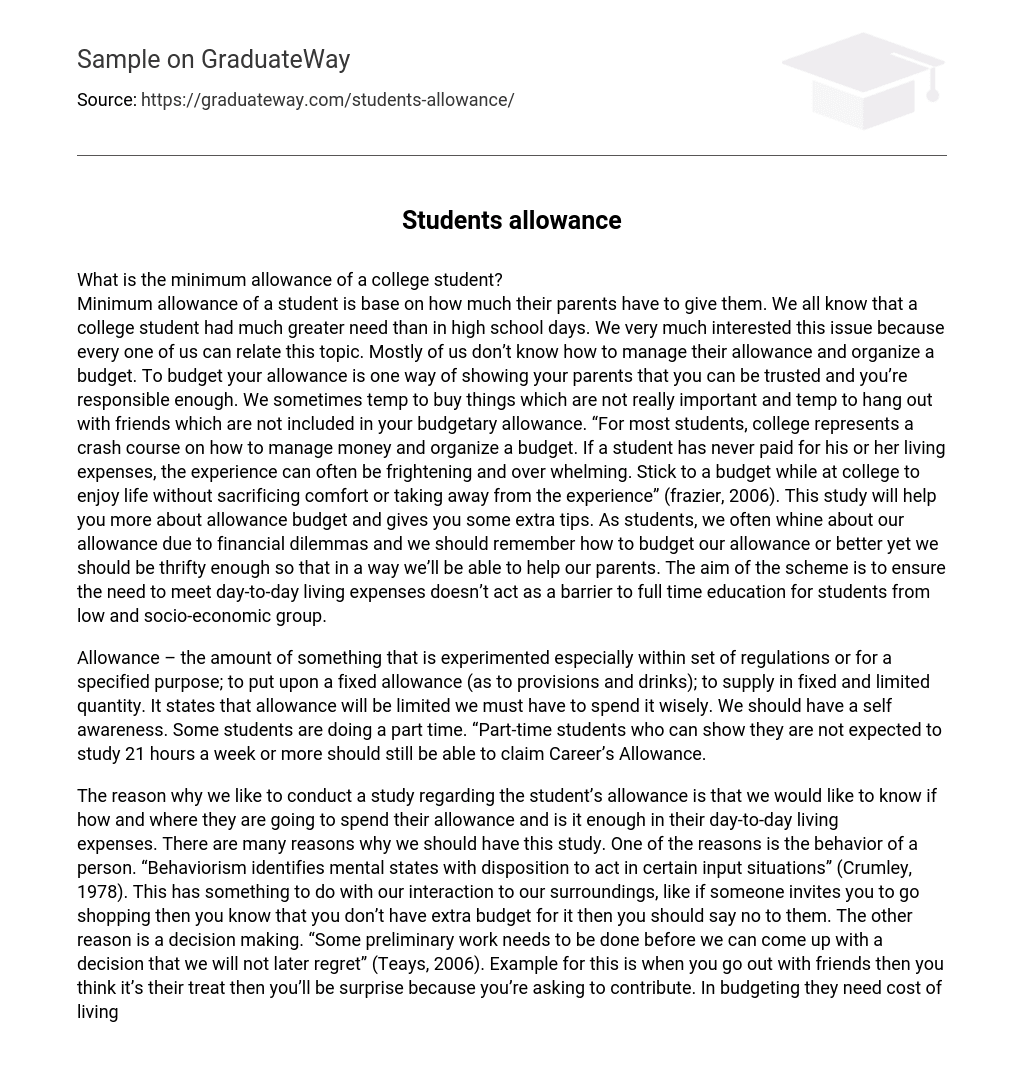What is the minimum allowance of a college student?
Minimum allowance of a student is base on how much their parents have to give them. We all know that a college student had much greater need than in high school days. We very much interested this issue because every one of us can relate this topic. Mostly of us don’t know how to manage their allowance and organize a budget. To budget your allowance is one way of showing your parents that you can be trusted and you’re responsible enough. We sometimes temp to buy things which are not really important and temp to hang out with friends which are not included in your budgetary allowance. “For most students, college represents a crash course on how to manage money and organize a budget. If a student has never paid for his or her living expenses, the experience can often be frightening and over whelming. Stick to a budget while at college to enjoy life without sacrificing comfort or taking away from the experience” (frazier, 2006). This study will help you more about allowance budget and gives you some extra tips. As students, we often whine about our allowance due to financial dilemmas and we should remember how to budget our allowance or better yet we should be thrifty enough so that in a way we’ll be able to help our parents. The aim of the scheme is to ensure the need to meet day-to-day living expenses doesn’t act as a barrier to full time education for students from low and socio-economic group.
The concept of allowance involves a limited amount of something, typically regulated or designated for a specific purpose. It may refer to the provision of a fixed amount of food and beverages, as well as the provision of a set and restricted quantity. The statement emphasizes that allowances are limited, therefore requiring mindful expenditure. It is important to cultivate self-awareness in managing allowances. Certain students engage in part-time work. “Part-time students who can demonstrate that they are not anticipated to devote 21 hours or more per week to studying should still be eligible to claim Career’s Allowance.”
The purpose of conducting a study on students’ allowance is to gain insight into their spending habits and whether it adequately covers their daily living expenses. There are several reasons why this study is important. Firstly, behavior plays a role in how we manage our money. According to Crumley (1978), behaviorism suggests that our actions are influenced by our surroundings and mental states. For example, if someone invites us to go shopping but we know we don’t have extra funds, we should decline.
Secondly, decision making is crucial when it comes to financial matters. Teays (2006) emphasizes the importance of doing preliminary work before making decisions that may result in regret later on. For instance, assuming friends will cover the expenses when going out but then being surprised when asked to contribute.
Lastly, considering the cost of living is vital for budgeting purposes. Student Financial Aid determines eligibility for financial aid each year by establishing a reasonable cost of living allowance which covers various expenses such as housing, utilities, food, transportation, personal and miscellaneous items as well as medical expenses.
Theoretical Background
Research on student spending has discovered that students worldwide have diverse ways of using their money. However, there are common trends in their spending behavior. In recent times, there has been a significant global shift in how young individuals spend their money. The commercial industry has always targeted the spending habits of students (IFIM Students Lifestyle and Spending Habits, 2009). A bank and financial institution conducted a study which revealed that youth typically allocate their funds towards activities such as purchasing cell phone load, playing computer games at Internet cafes, buying cigarettes and alcohol, socializing outings, and shopping for clothing and accessories (TJ Manotoc, ABS-CBN News, 2010).
According to Tempo (2010), teenagers are influential consumers who actively spend money and shape societal trends. Despite growing up during a time of rapid change, they display confidence in their decision-making abilities. Many teenagers prioritize staying on-trend and following what is currently popular. They typically receive income from allowances or part-time jobs, which is not determined by their family’s income or social status but rather by the parents’ upbringing and lifestyle choices (Felipe, 2007). Ming Barcelona, TNS Philippines Associate Research Director, states that Filipino teens do not solely prefer low-priced brands due to limited budgets. Gary de Ocampo, TNS Philippines Managing Director, highlights the importance of understanding Filipino teenagers’ mindsets, preferences, purchasing habits, as well as their views on brand values, product offerings, and social issues (TRU study).
The study focuses on the Student’s Allowance at La Salle University, Ozamiz City. It aims to address the following questions: 1. How do parents provide allowance to their children? 2. What is the frequency of the allowance (daily, weekly or monthly)? 3. Do students manage their own budget?
In. Significance of the Study.
This study highlights the importance of La Salle University students being aware of their parents’ expenses and finding ways to reduce financial issues. One way to overcome this predicament is for students to have part-time jobs in order to remove the barrier of financial concerns on their academic performance. Additionally, students should practice thriftiness and wise money management. For future researchers, it would be beneficial to include the effects of these measures.
V. Scope and Limitations.
The study focused on the portrayal of students wasting their money allowance. Researchers aimed to promote proper usage of allowance to ensure students’ long-term financial well-being. They examined various approaches and limitations by analyzing images of female students’ allowances through different models. The research compared these changing images to present-day students. The topic was chosen to highlight the significance of womanhood and gain a deeper understanding of the evolving roles of students across time.





